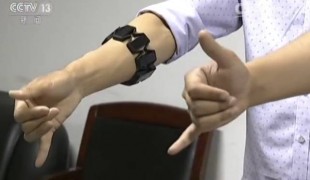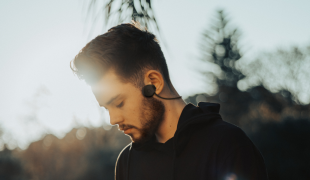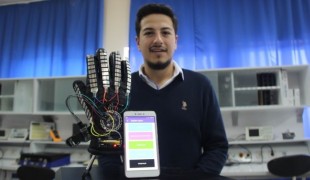- 4255
- 246
- 17
- 12
- 0
- Help Ukraine
About the solution
The eWhistle is worn like a regular whistle by the referee but has a transmitter. It is worn by the athlete like a watch. When the whistle is blown, an electric current is sent to the transmitter, via radio, which signals the user. This way the athlete is notified by the referee by vibration and LED lights. The transmitter-receiver system works like a doorbell, but with light and vibration instead of sound.
"My innovation is called the e-Whistle, a device to help people with a hearing disability play team sports by electronically signalling when the whistle is blown. Instead of sound waves, the eWhistle transmits a radio signal – making a player’s wrist band vibrate and light up”, the girl explained.
The first version of the gadget was cased inside an Apple headphone case, but then Kate created her own case using 3D printing technology. The design also features an inter-changeable soft silicon wrist brand that allows the e-Whistle to be used in physical games, without risking damage to the unit or injury to other players.
The device, still a prototype, has a range of the 200 metres. Kate plans to make it shorter for games like netball, so that the transmitter box can be made smaller. She is also looking to improve it by making it more comfortable and discrete. “I want it to be discrete because if someone has a hearing disability, I don't want to make it obvious”, the inventor justified.
Kate is now getting the gadget patented.
"My goal is to get the e-Whistle developed to a level of completion where it can be confidently pitched to the Ministry of Education, with the aim of getting it in all New Zealand schools. Every student deserves the chance to participate in their favourite sport and not be excluded because of a hearing disability. It remains a strong personal goal of mine to develop the eWhistle to a point where I can take it to market. My next steps are: Test the new small transmitter chipset to determine if this is a viable replacement option for the current transmitter unit; Refine the 3D modelling, adding in a separate compartment for batteries and improving closure mechanisms; Get the samples professionally printed. The finish quality on my samples is a good as our school printers can produce. Produce multiple samples and run full field tests with actual users – including a waterproof option”, the inventor described.
This innovation lead Kate to win 1st place in Junior Best Concept (Sponsored by Shift), Best Overall Female (Sponsored by ASB) and 3rd place in Junior Engineering (Sponsored by MIT), and the Junior Excellence Award from the North Harbour Club (sponsored by Library Lane and NZ Force Construction – including a cash grant of $3,000).
Adapted from: https://bit.ly/2ZgpjFK
https://bit.ly/2ZgpyAE
https://bit.ly/2Z9sr65
https://www.youtube.com/watch?v=4abHGlj0Rf4
This solution shall not include mention to the use of drugs, chemicals or biologicals (including food); invasive devices; offensive, commercial or inherently dangerous content. This solution was not medically validated. Proceed with caution! If you have any doubts, please consult with a health professional.
DISCLAIMER: This story was written by someone who is not the author of the solution, therefore please be advised that, although it was written with the utmost respect for the innovation and the innovator, there can be some incorrect statements. If you find any errors please contact the patient Innovation team via info@patient-innovation.com
-
-
548
-
0
-
9312

Girls create translation armband for the deaf
COMMUNICATION: Communicating, whether by speaking, listening, or other means
Social interaction
Congenital Deafness
Hearing Disorders
Ear and Labyrinth Disorders
5 Senses support devices: (glasses, hearing aids, headphones...)
Assistive Daily Life Device (to help ADL)
Body-Worn solutions (Clothing, accessories, shoes, sensors...)
Hearing loss or ringing in the ears (tinnitus)
Managing Neurological Disorders
Promoting inclusivity and social integration
Improving Speech and Communication
General and Family Medicine
Neurology
Otorhinolaryngology
China
-
-
-
430
-
0
-
9327

Pedro, an acoustic engineer designed an open-ear hearable device in order to allow everyone to listen to music!
COMMUNICATION: Communicating, whether by speaking, listening, or other means
Hearing Disorders
5 Senses support devices: (glasses, hearing aids, headphones...)
Assistive Technology access
Body-Worn solutions (Clothing, accessories, shoes, sensors...)
Regaining sensory function
Promoting self-management
Promoting inclusivity and social integration
Improving Speech and Communication
Raise awareness
General and Family Medicine
Internal Medicine
Neurology
Otorhinolaryngology
Denmark
-
-
-
258
-
2
-
3180

Student invents glove that translates sign language into text
COMMUNICATION: Communicating, whether by speaking, listening, or other means
Social interaction
Blindness
Visual Impairment
Hearing Disorders
Congenital Deafness
Speech Disorder
App (Including when connected with wearable)
Body-Worn solutions (Clothing, accessories, shoes, sensors...)
5 Senses support devices: (glasses, hearing aids, headphones...)
Vision problems
Difficulty speaking or understanding speech
Hearing loss or ringing in the ears (tinnitus)
Regaining sensory function
Promoting inclusivity and social integration
Improving Speech and Communication
Neurology
Ophthalmology
Otorhinolaryngology
Turkey
-
 en
en